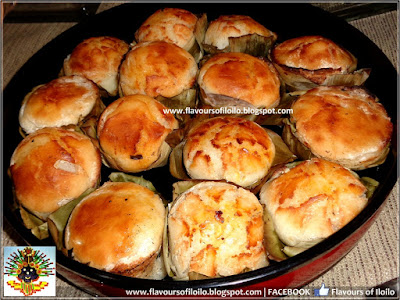
I was no more than 10 years old when I first witnessed the Feast of San Jose ritual in my lola's house in Molo. I can still vividly remember the "role-playing" which had elements of washing, eating and "kissing". And it was only a few years ago (after decades of absence) that I "revisited" this personal experience - now aimed with more understanding of the traditions and rituals involved in the celebration.
March 19 is the Feast day of St. Joseph and last Saturday, I was Camiña Balay nga Bato in Arevalo to join in the traditional San Jose breakfast feast that also doubled as a family reunion of the Avanceña-Melocoton clans.
In the Philippines particularly in rice producing provinces like Iloilo, many families keep a tradition in which an old man, a young lady, and a small boy are chosen from among the poor and are dressed up as St. Joseph, the Virgin Mary, and the child Jesus, respectively.
They are then seated around a table set with the family's best silverware and china, and served a variety of courses, sometimes being literally spoon-fed by the senior members of the family, while the Novena to St. Joseph is recited at a nearby temporary altar. (from Wikipedia)
The house guests would then take turns in kissing/kneeling before the estampita representing the three figures. Money offering would be placed in a bowl at the middle of the table and when the ritual is over it would be divided among the three.
Everybody would then join in the gastronomical feast prepared by the household - whether its breakfast, lunch or meryenda. And when it comes to food, Camiña Balay nga Bato never fails the satisfy one's appetite!
As it was a "prelude" to the Holy Week where fasting and abstinence is the norm, it was a fest of meat as if to say that "we're meating now instead of next week". So there was Beef Tapa and Skinless Longganisa
 |
Cocido - a sort of Ilonggo pochero with even more ingredients including a side dish of mashed eggplant.
Corned beef with kalabasa hash instead of potato...and Fried Lumpia Togue on the side.
There's a big bowl of Pork and Beans topped with hard-boiled eggs.
A mish-mash of tomatoes, onions and leeks...
...to complement an inviting plate of fried salted fish.Sunny side up eggs done my favorite way - tostado, with almost crispy sides.
There's also a vegetable pasta with tomato sauce, mushrooms, olives and more.
Appetizer or dessert? The fried saba never fails to get my attention.
A plate bibingka imported from Santa Barbara...
... and some Puto Lanson.
Puto manapla (yes, even without the traditional banana leaves base) came in plain and ube variants.
Plus mangoes to make a perfect partner with ibos and suman latik.
And it won't be a complete Camiña Balay nga Bato experience without having a taste of their signature and often imitated tsokolate de batirol.
Another celebration has come and gone but the memories - tradition, rituals and gastronomic, still lingers on as we wait for another year of experiencing the feast of San Jose.




















